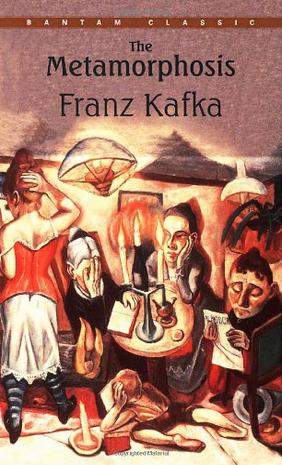The Metamorphosis
内容简介
Writings by and about Kafka and textual notes accompany this translation of his early-twentieth-century work.
The Metamorphosis (in German, Die Verwandlung) is a novella by Franz Kafka, first published in 1915, and arguably the most famous of his works along with the longer works The Trial and The Castle. The story begins with a traveling salesman, Gregor Samsa, waking to find himself transformed into a giant "monstrous vermin" (see Lost in translation, below). It is widely regarded as a highly symbolic tale with various interpretations.
From Publishers Weekly
Kuper has adapted short works by Kafka into comics before, but here he tackles the most famous one of all: the jet-black comedy that ensues after the luckless Gregor Samsa turns into a gigantic bug. The story loses a bit in translation (and the typeset text looks awkward in the context of Kuper's distinctly handmade drawings). A lot of the humor in the original comes from the way Kafka plays the story's absurdities absolutely deadpan, and the visuals oversell the joke, especially since Kuper draws all the human characters as broad caricatures. Even so, he works up a suitably creepy frisson, mostly thanks to his drawing style. Executed on scratchboard, it's a jittery, woodcut-inspired mass of sharp angles that owes a debt to both Frans Masereel (a Belgian woodcut artist who worked around Kafka's time) and MAD magazine's Will Elder. The knotty walls and floors of the Samsas' house look like they're about to dissolve into dust. In the book's best moments, Kuper lets his unerring design sense and command of visual shorthand carry the story. The jagged forms on the huge insect's belly are mirrored by folds in business clothes; thinking about the debt his parents owe his employer, Gregor imagines his insectoid body turning into money slipping through an hourglass. Every thing and person in this Metamorphosis seems silhouetted and carved, an effect that meshes neatly with Kafka's sense of nightmarish unreality.
From School Library Journal
Adult/High School-Gregor Samsa wakes up and discovers he has been changed into a giant cockroach. Thus begins "The Metamorphosis," and Kuper translates this story masterfully with his scratchboard illustrations. The text is more spare, but the visuals are so strongly rendered that little of the original is changed or omitted. Though the story remains set in Kafka's time, Kuper has added some present-day touches, such as fast-food restaurants, that do not detract from the tale. He has used the medium creatively, employing unusual perspectives and panel shapes, and text that even crawls on the walls and ceilings, as Gregor does. The roach has an insect body but human facial expressions. Once he is pelted with the apple, readers can watch his rapid decline, as his body becomes more wizened and his face more gaunt. This is a faithful rendition rather than an illustrated abridgment.
---Jamie Watson, Enoch Pratt Free Library, Baltimore
Book Dimension
Height (mm) 175 Width (mm) 105
......(更多)
作者简介
Franz Kafka[a] (3 July 1883 – 3 June 1924) was a German-speaking Bohemian Jewish novelist and short story writer, widely regarded as one of the major figures of 20th-century literature. His work, which fuses elements of realism and the fantastic,[3] typically features isolated protagonists faced by bizarre or surrealistic predicaments and incomprehensible social-bureaucratic powers, and has been interpreted as exploring themes of alienation, existential anxiety, guilt, and absurdity.[4] His best known works include "Die Verwandlung" ("The Metamorphosis"), Der Process (The Trial), and Das Schloss (The Castle). The term Kafkaesque has entered the English language to describe situations like those in his writing.[5]
Kafka was born into a middle-class, German-speaking Jewish family in Prague, the capital of the Kingdom of Bohemia, then part of the Austro-Hungarian Empire, today part of the Czech Republic. He trained as a lawyer, and after completing his legal education he was employed by an insurance company, forcing him to relegate writing to his spare time. Over the course of his life, Kafka wrote hundreds of letters to family and close friends, including his father, with whom he had a strained and formal relationship. He became engaged to several women but never married. He died in 1924 at the age of 40 from tuberculosis.
Few of Kafka's works were published during his lifetime: the story collections Betrachtung (Contemplation) and Ein Landarzt (A Country Doctor), and individual stories (such as "Die Verwandlung") were published in literary magazines but received little public attention. Kafka's unfinished works, including his novels Der Process, Das Schloss and Amerika (also known as Der Verschollene, The Man Who Disappeared), were ordered by Kafka to be destroyed by his friend Max Brod, who nonetheless ignored his friend's direction and published them after Kafka's death. His work went on to influence a vast range of writers, critics, artists, and philosophers during the 20th century.
......(更多)
目录
......(更多)
读书文摘
不,我需要的不是自由,而是出路,左边或右边,随便哪个方向都行。我别无他求,哪怕这出路只是假想出来自我安慰,我的要求极低,所以不会再有更大的失望。向前,向前!只要不是只抬着胳膊贴在一块木箱板上一动不动 今天我很清楚地明白了,没有内心极大的平静我永远都別想出去。我能有今天确实要归功于我在船上时头几天的镇静,而我镇静的功劳应当属于船上的人们。
我们心情舒畅,唱着歌挤成一团。一个人把自己的声音混入别人的歌声中,他就仿佛被一个鱼钩钩住了。
我在自己的家里,在那些最好、最亲爱的人们中间比陌生人还要陌生。
......(更多)






